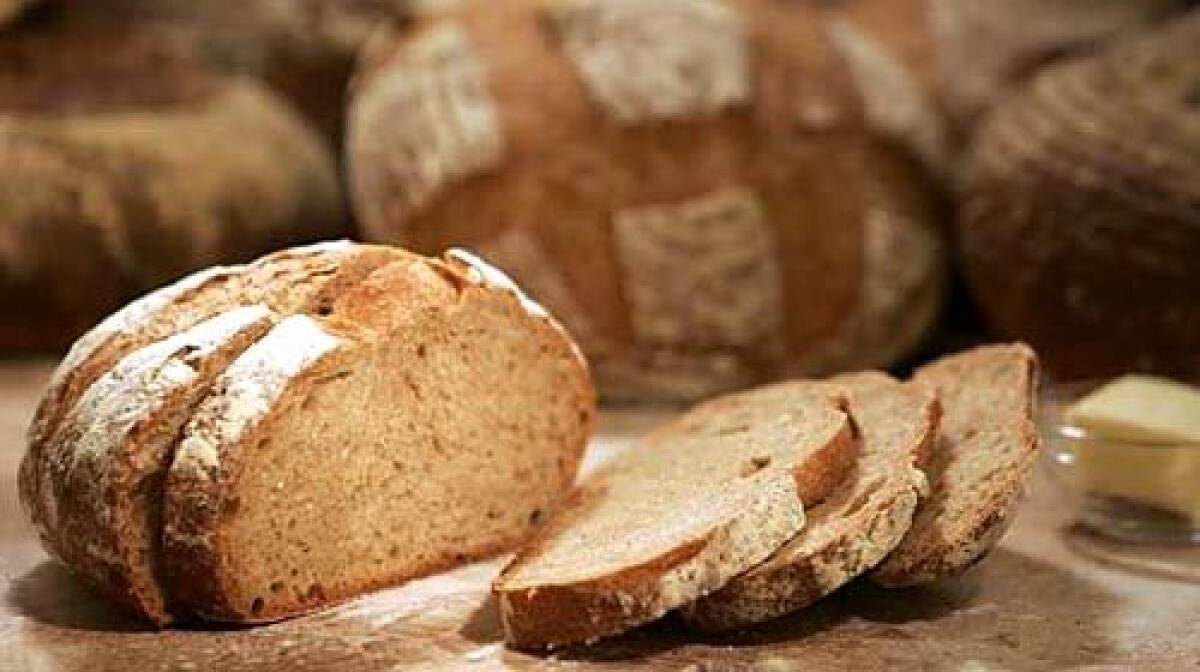Scaling Mt. Sourdough

- Share via
THERE are few things as treasured, in home kitchens or professional bakeries, as sourdough starter. Bread bakers feed it religiously, on a strict schedule, like pets or children; they carry the stuff with them when they move; they hand down jars of it through generations like heirloom jewelry.
It may look like a forgotten tub of kids’ glue or papier-mâché paste -- lodged in the back of the refrigerator or slowly bubbling on a counter top -- but just a bit of it is enough to leaven a loaf of crusty, fragrant bread and flavor it with the gloriously distinctive tang of sourdough. It’s a beautiful, mysterious alchemy that produces gorgeous boules (round loaves), baguettes, even pancakes from such simple ingredients -- no commercial yeast necessary. But it’s just flour and water, wild yeast and lactobacilli; it’s not smoke and mirrors.
For the weeks I experimented with sourdough starter, my kitchen felt and looked like an alchemist’s laboratory. Starters proliferated in bowls and jars on every available surface. I grew them from cheesecloth bags of organic grapes; pots of cooked potatoes; I used bags of stone-ground rye, organic whole wheat, bread and all-purpose flours; I reactivated dried powders under homemade, jury-rigged proofing boxes outfitted with lightbulbs; I stirred and fed starters that I’d begged from a Michelin-starred restaurant, traded at farmers market stalls and received by mail in little plastic bags like a federally controlled substance.
In the end, I had a basic starter I loved (made with pineapple juice and whole wheat flour), rapidly multiplying loaves of amazing bread, an understanding of how truly simple the process is -- and an appreciation of why many bakers are as fanatic about their starters as baseball players can be about their socks.
Inside the new kitchens of Boule in Los Angeles, chef de boulangerie Hidefumi Kubota nurtures a starter that can trace its origins back a century, to a kitchen in Puglia, Italy. A few streets away, at Bastide, pastry chef Margarita Manzke’s starter is one she made (rye flour, malt powder) in Carmel four years ago. At AOC, the sourdough starter is one originally given to the restaurant by farmer Bill Spenser of Windrose Farms, who made his years ago using La Brea Bakery founder Nancy Silverton’s recipe (bread flour, organic grapes).
As for Silverton, the patron saint of sourdough-bread bakers in this town, she says you can trace the starter used in every La Brea Bakery sourdough bread back to the original white starter she made before opening her bakery. “Supposedly I’m going to be going to Ireland with a bucket of starter soon,” Silverton said. (Silverton sold La Brea Bakery to Dublin-based IAWS Group in 2001 but is still active in the company.)
Bakers have been making sourdough bread for centuries, even millenniums. The first risen loaves were made possibly when someone left a bowl of flour-and-water paste out and forgot about it, returning later to find that it had begun to ferment and grow.
The right balance
MAKING your own sourdough starter is just about this uncomplicated. Basically, it’s mixing flour and water and waiting for the wild yeasts and bacteria present on the grains to gain footing. Over the course of about a week, and with increasingly frequent feedings of flour and water, a sourdough culture establishes itself within the petri dish of your bowl and reaches equilibrium. The bacteria, from which the starter gets its acidity and characteristic sourness, and the yeasts, which leaven it -- and eventually the bread -- achieve a balance.
That’s the basic idea. But there are as many ways to achieve this as there are bread-baking enthusiasts. Some add a mash of organic grapes to the initial blend; others add cooked potatoes or raisin water or apple peels to help kick off the process. Others swear by only flour and water. And then there’s pineapple juice.
In his new book “Whole Grain Breads: New Techniques, Extraordinary Flavor,” author and baking instructor Peter Reinhart outlines “the pineapple solution,” a recipe that replaces the water in the initial starter mixture with pineapple juice. (It was developed by home baker Debra Wink and fellow members of the King Arthur Baking Circle, who came up with it as a way of avoiding the development of certain growth-inhibiting bacteria.)
I made successful starters with organic grapes, potatoes, water and various flours, even the heel of an old piece of my own sourdough bread (following a tip from cookbook author Naomi Duguid). But the pineapple juice method made the quickest, strongest and most reliable starter. It grew into an active, consistently vigorous, bubbling culture that would leaven a loaf of good bread in a little more than a week, as opposed to the two weeks or more it generally took the other starters. No mold, no wacky aromas or strange discoloration, no days of disheartening inactivity.
Then there’s the question of what flour to use, what water. Although you can probably grow a sourdough culture out of almost any flour and water mixture if you wait long enough, it makes sense that the quality of your essential ingredients will contribute to the quality of your starter. Use high-quality, fresh, organic whole grain flours (which carry more abundant wild yeasts and bacteria) and non-chlorinated water.
After you mix the initial ingredients, it’s just a matter of waiting -- for the dough to ferment, for the yeasts and bacteria to develop -- and feeding it regularly and consistently as you would, say, a goldfish. Moving your bowl to a warm part of the house helps, as does stirring your starter a few times a day, as it benefits from aeration.
Eventually your starter will grow and flourish, fermenting and bubbling, rising and falling as you feed it. No incantations necessary. If you don’t want to make your own starter, there are alternatives. Because sourdough starter grows exponentially, and bakers often have far more than they need, you can ask for some from a friend -- or even from a bakery. You can also order established starter from a number of sources online and by mail, including King Arthur Flour (kingarthurflour.com), breadtopia.com, and Friends of Carl, a group of people who maintain a starter originally begun in Oregon in 1847 (send an SASE to Oregon Trail Sourdough, P. O. Box 32, Jefferson, MD 21755).
Or order a dried culture from Sourdough International’s Ed Wood, a retired pathologist and baker who has spent decades collecting wild yeast starters from around the world. Wood has cultures from San Francisco, Egypt, Italy, Bahrain and elsewhere, each, he says, with their own distinct flavor; they’re available at sourdo.com. (Note: Wood calls for that jury-rigged proofing box.)
Playing with starters
BUT making your own is a lot of fun. Consider it a science project. You’re creating a household pet, in effect: a water-and-flour creature with its own personality. My kids loved watching the cultures bubble and grow; they even named their three favorites of the 18 different starters in my refrigerator.
Keep your starter in a glass or clear plastic container so you can see the structure as it grows. It will take you about a week to get an active culture, with not much attention required in the first few days, followed by a few days of up to two feedings per day. After you have a strong and healthy starter, its care is a lot less demanding. Stored in the refrigerator and fed only weekly (or even less frequently), a starter can last indefinitely, hibernating and dormant in the cold.
(My mother had a Mason jar of starter in the back of the refrigerator, its color and consistency like thick yogurt. I remember her pulling it out, stirring in some water, some flour, and then back it would go. Sometimes she’d go months between baking binges.)
If you forget, or if your starter begins to look or smell odd (a layer of liquid, called hooch, usually forms on top of a stored starter; just stir it back in when you feed it), regular and frequent feedings should bring it back into balance. Keep it at room temperature while you recalibrate it.
These recipes call for feedings of equal parts by weight of flour and water, producing a starter that has 100% hydration, according to baker’s percentages. If you don’t bake regularly with your starter (and even if you do), you’ll need to discard some of it each time you feed it.
Maybe this is why there are so many creative ways to use excess sourdough starter. Silverton devotes an entire chapter in “Breads From the La Brea Bakery” to non-bread recipes that call for starter, including bagels, onion rings, blini, even dog biscuits and chocolate cake. I’ve used it as a batter to fry fish.
And sourdough starter is just as malleable in the jar as out of it: After you’ve created a strong starter with whole wheat or rye flour, you can easily convert it to a white starter simply by feeding it all-purpose instead of whole grain flour.
With all the variables at play in your kitchen and in your life, a trusty jar of sourdough starter may be that one thing that you can rely on: passed among kitchens and between generations, leavening bread after bread. That alone makes it magical.
More to Read
Sign up for The Wild
We’ll help you find the best places to hike, bike and run, as well as the perfect silent spots for meditation and yoga.
You may occasionally receive promotional content from the Los Angeles Times.










